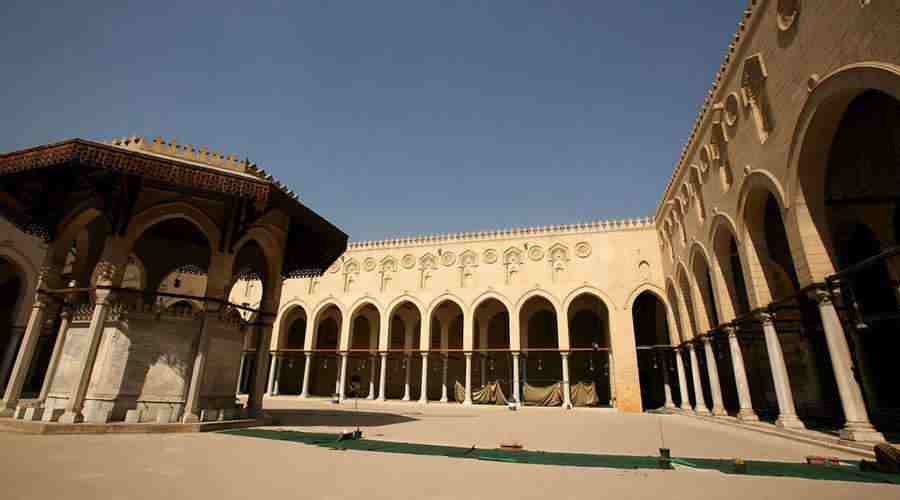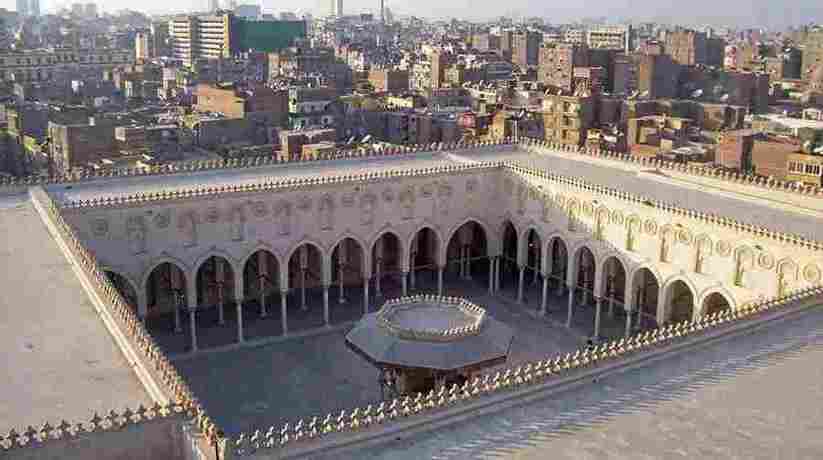Al Muayyad mosque Cairo Egypt tours, booking, prices, reviews
Al Muayyad mosque Cairo and complex situated next to Bab Zuweila in Cairo. In fact, Al Muayyad complex contained a madrasa-khanqah, mosque and two mausoleums. Al Muayyad mosque Cairo and complex built between 1415 and 1422. Moreover, Al Muayyad Madrasa dedicated to Sufis only. The curriculum comprised the study of official religion according to the four rites. It is unlike Barquq’s madrasa-khanqah. In Barquq’s madrasa-khanqah, students dwelt under the same roof. They enjoyed exposure to each other’s teachings and religious practices. The mosque and complex built by Sultan Al Muayyad. Sultan Al Muayyad (Al Mu’ayyad) was a pious and oppressive man, but he was also a musician and poet. His reign cursed by plague and by his own unusual currency reforms.
When he died, everyone engaged in choosing his successor. Nobody attended his funeral and his body wasn’t wrapped with a towel. Al Muayyad mosque Cairo and it’s minarets became a land mark of Cairo. The site had unpleasant connotations because there was a prison adjoining Bab Zuweila. That is why they say that Al Muayyad was lucky to live when he was a prince. Sultan Al Muayyad Shaykh was a Burgi or Circassian Mamluk. In fact, he served as sultan between 1412 and 1421. Al-Maqrizi relates that during the reign of Farag ibn Barquq, Al Mu’ayyad captured. And he thrown into the prison on this site. He suffered from the lice, the fleas and vowed. When he came to power he would transform the infested prison into a “place for the education of scholars”.
Further details about Al Muayyad mosque Cairo:
Once he became sultan, he soon fulfilled his promise. Moreover, he spent some 40,000 dinars on its construction. “Marble taken from everywhere”. It relates the 15th century historian al-Taghribirdi, “even from (private) houses and palaces. The prize of marble in Egypt soon rose to astronomical height for the vast demand. It also does to the big dimensions of the mosque. Al Muayyad mosque Cairo became indeed the most beautiful mosque which built in Cairo. It is because of decoration and the use of marbles. Many donkeys occupied to carry away loads of bones of the dead which found in the prison. Due to the Sultan’s lavish endowments, the madrasa became one of the most prominent academic institutions. A large library collected. The most eminent scholars of the day filled professorial chairs.
Ibn Hagar al-‘Asqalani was The most famous specialist in Quranic exegesis in Egypt. He installed as lecturer in Shafi’i jurisprudence. There was a great ceremony for the opening of Al Muayyad madrasa. It was when Al Muayyad and his Mamluk entourage came down from the Citadel. The water basin in the middle of the vast courtyard filled with liquefied sugar and sweets. Al Muayyad mosque Cairo had three minarets. This is including the two we see above the towers of Bab Zuweila. They are twins. The third one, near the western entrance, was different in appearance. It destroyed sometime during the 19th century. The two remaining ones, though they present no innovation in the evolution of minarets. They are particularly slender and elegant with their zigzag carved shafts.
More details about mosque of Al Muayyad Cairo:
Noteworthy, is the signature of their architect. Moreover, they carved on a cartouche above the entrance to their staircases. They are on the northern side of each shaft and dating to 1419 and 1420 (AD). In fact, his name was al-Mu’allim Muhammad Ibn Al Qazzaz. This is the only which known signature of a Mamluk architect on a building. There is a story which related to the remaining minarets. It seems that after their completion, one began to lean dangerously towards one of the neighboring buildings. It decided to tear down the newly built minaret and rebuild it. The demolition work alone took a whole day, during which one of the local workers killed by falling pieces. Afterwards, Bab Zuweila closed for a whole month.
In fact, Al Muayyad mosque Cairo had four facades and four entrances. Moreover, the two main facades are the one parallel to Bab Zuweila. It is on the site of the Fatimid southern city wall. And which rebuilt in the 19th century. The facade is perpendicular to Bab Zuweila on its left with the main portal. Furthermore, the muqarnas portal is of grand proportions. It enhanced by a pishtaq or wall above the entrance that is higher than the others. A conch rests on a large vault. It is where nine tiers of dripping stalactites have incorporated. A band of carved stone inlaid with marble and red and turquoise colored stones frames the doorway. The panels on either side of the portal have examples of square Kufic. They are an arrangement of the shahada.
Further details about Al Muayyad complex Cairo:
Shahada is the first pillar of Islam, “There is no god but God; Muhammad is the Messenger of God.”Over the portal and on the bays to either side of the door is a Quranic inscription. It used in religious buildings. The door is indeed a masterpiece of bronze metalwork. In fact, it taken, along with a bronze chandelier from Sultan Hassan mosque. Moreover, it was against payment of a sum of five hundred dinar. Islamic law prohibits the acquisition of land or other properties for a new foundation. Once endowed, a property cannot change owners. Maqrizi mentions many such illegal acts connected with the foundation of religious buildings. Inside the complex, the vestibule covered by a magnificent groin cross-vault.
Moreover, it flanked by two half-domes on stalactites. It is perhaps the most remarkable feature of the entire complex. Today, one enters Al Muayyad mosque Cairo, he thinks it is a mausoleum. There was direct access into the courtyard. Furthermore, the mausoleum dome has an exterior like that of Faraj Ibn Barquq. In fact, it is smaller and has two cenotaphs. This is where Sultan Al Muayyad and his son buried. In fact, one of the cenotaphs is larger than the other. It is with remarkable Kufic inscriptions in marble which crafted during the Ikhshidid. Their texts are Quranic. In fact, they taken from an earlier building. These “foliate” beginnings lead to lush arabesque backgrounds for scripts.
More details about Al Muayyad mausoleum Cairo:
On the top part of the north western wall of the mausoleum, there are two blind windows. Moreover, they feature carved stucco decorations in the Andalusia style. The hypo-style plan of the Congregational mosque is like that of the khanqah of Faraj Ibn Barquq. But on columns rather than piers. This is a late example in Cairo of the open courtyard plan on a large scale. In fact, it is the last such hypo style mosque to build in Cairo. There is an ablution fountain in the middle of the courtyard. Of the four iwans, only the sanctuary section survived. There were plans for it to be flanked on either side by a domed mausoleum. In fact, only one built. This is where the tombs of the female members of the Family buried, though there is no mausoleum.
The sanctuary decorated with a high marble dado and a polychrome marble prayer niche. Moreover, it is with a row of inlaid niches which separated by blue glass colonnettes. A painted gilded wooden ceiling, stucco grilled windows and beautiful doors inlaid with wood and ivory. Besides to the marble columns with their pre-Islamic capitals. They contribute to the richness of the decoration. The prayer hall restored during the 19th century. It was when Ibrahim Pasha, the son of Muhammad ‘Ali, installed Turkish tiles. That were inset into the qibla wall. It was at that time that the ruined iwans torn down but only the western one rebuilt. The rest of the area turned into a garden. It was once again restored in more recent times.
Further details about Al Muayyad mosque Cairo:
In 2001, the Ministry of Culture removed the garden and. It rebuilt the missing arcades around the courtyard. The mosque also has its original wood and ivory pulpit. A doorway at one end of the sanctuary leads to the second story platform of the Bab Zuweila. It also leads to the minarets. In fact, the living quarters of the Sufi students were not around the courtyard as they are at Faraj’s khanqah. They formed a separate structure consisting of a courtyard. They surrounded by several stories of living units. It no longer exits. On the western side of the mosque. Sultan Al Muayyad built a hammam (bath). The pendentive in it that once supported a dome have remarkable stalactites.
















